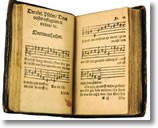by Jonathan Swett
 Johann Walter lived through the early and late years of the Lutheran Reformation, and as the “first cantor of the Lutheran Church,” significantly shaped the musical life of the church of that period and the centuries that followed. Much like Martin Luther, Walter devoted considerable effort to developing a proper understanding of the use of music in the Christian community and chose a most interesting medium to catechize the faithful—in 1538 he crafted Lob und Preis der loeblichen Kunst Musica (In Praise of the Noble Art of Music), a rhymed didactic poem of 324 lines which expresses a theology of music based on Reformation insights.
Johann Walter lived through the early and late years of the Lutheran Reformation, and as the “first cantor of the Lutheran Church,” significantly shaped the musical life of the church of that period and the centuries that followed. Much like Martin Luther, Walter devoted considerable effort to developing a proper understanding of the use of music in the Christian community and chose a most interesting medium to catechize the faithful—in 1538 he crafted Lob und Preis der loeblichen Kunst Musica (In Praise of the Noble Art of Music), a rhymed didactic poem of 324 lines which expresses a theology of music based on Reformation insights.
Born in Kahla in central Germany in 1496 where he likely attended the Latin school and served as a choirboy, little else is known of Walter until he entered the court chapel of Frederick the Wise in 1517 to serve as a bass singer and composer. In 1524—the same year he became Kapellmeister in Torgau, and with Luther’s encouragement and guidance—Walter published his Geystliche gesangk Buchleyn, a collection of 43 pieces for three, four, and five voices arranged according to the church year. The vast majority of the pieces were cantus-firmus compositions with the melody in the tenor part and were intended for use by church choirs and in the instruction of youth in schools—a sentiment shared by Luther in the preface he provided to the collection. Occasionally, Walter placed the cantus-firmus melody in the upper voice which would become the norm by the end of the 16th century.
One year later, Luther enlisted the help of Walter and his mentor, Conrad Rupsch, to prepare music for his Deudsche Messe (German Mass). In a later description of the work, Walter offered high praise of Luther’s musical aptitude and regard for the importance of the theological use of music: “And one sees, hears, and understands at once how the Holy Spirit has been active not only in the authors who composed the Latin hymns and set them to music, but in Herr Luther himself, who now has invented most of the poetry and melody of the German chants. And it can be seen from the German Sanctus how he arranged all the notes to the text with the right accent and concent in masterly fashion.”1
 Following the death of Elector Frederick the Wise and succession of John the Steadfast in 1525, a period of decline and uncertainty arose in which Melanchthon and Luther were swift to advocate for music and Walter’s service. In 1526 Melanchthon wrote to John the Steadfast, “Why should the noble art of music not remain active now for God’s sake, since it is used for the service and glory of God.”2 The same day Luther also addressed the new Elector, “The art of music is worthy of being supported by Princes and Lords, much more so than many other endeavors and enterprises for which there is not nearly so much need.”3
Following the death of Elector Frederick the Wise and succession of John the Steadfast in 1525, a period of decline and uncertainty arose in which Melanchthon and Luther were swift to advocate for music and Walter’s service. In 1526 Melanchthon wrote to John the Steadfast, “Why should the noble art of music not remain active now for God’s sake, since it is used for the service and glory of God.”2 The same day Luther also addressed the new Elector, “The art of music is worthy of being supported by Princes and Lords, much more so than many other endeavors and enterprises for which there is not nearly so much need.”3
Walter married Anna Hesse in June of 1526, and following the inevitable disbandment of the Hofkapelle, assumed the position of cantor at the Municipal Latin School in Torgau. He also became director for a group of musical amateur citizens who met together to sing and study music known as the Stadtkantorei. Walter’s devotion to the city and school choirs served as a model in the region and had a significant impact on the development and advancement of music during the Reformation period. In 1548, in the midst of the tumultuous time following Luther’s death two years prior, Walter accepted the invitation of the new Elector Moritz to organize and direct music for the court chapel in Dresden. After six short years he returned to Torgau—where his only son, Johann, still resided—and where he would later die on March 25, 1570.
Aside from Walter’s compositional output for the liturgical service, other notable works include his widely used Passion settings (a development which culminated in the settings of Johann Sebastian Bach in the early 1700s), an homage-motet based on Psalm 119 for the October 3, 1544 dedication of the first church building built by Lutherans (Chapel of the Castle Hartenfels), and a large-scale collection of polyphonic music as a tribute to Luther and based on his “very last hymn”—Das christlich Kinderlied D. Martini Lutheri Erhalt uns Herr (1566). The final stanza of the only hymn text of Walter’s to appear in Lutheran Service Book, “The Bridegroom Soon Will Call Us,” is a fitting summary of the great influence of the “father of Lutheran church music” on the future beyond Walter in this world and the heavenly worship of the Church everlasting.
“In that fair home shall never be silent music’s voice;
With hearts and lips forever we shall in God rejoice,
While angel hosts are raising with saints from great to least
A mighty hymn for praising the Giver of the feast.”4
Jonathan A. Swett is Kantor of Our Savior Evangelical Lutheran Church and School, Hartland, MI.
Most information for this article is paraphrased from:
Schalk, Carl. Music in Early Lutheranism. St. Louis: Concordia Academic Press, 2001.
1 Verba des alten Johann Walters in Michael Praetorius’ Syntagma musicum I (Wittenberg, 1614/15), 449-53. Quoted from Paul Nettl, Luther on Music (Philadelphia: Muhlenberg, 1948), 75-76.
2 Quoted in Walter E. Buszin, Luther on Music, Pamphlet Series, no. 3, (ed. Johannes Riedel; St. Paul: Lutheran Society for Worship, Music and the Arts, 1958), 8-9.
3 Ibid., 9.
4 Public domain

